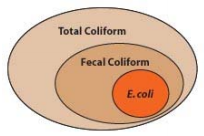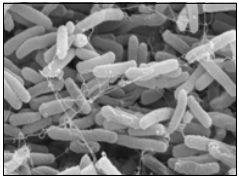How Common Is E Coli In Well Water
View/Download PDF Version
 What are Full Coliform and E. coli Bacteria?
What are Full Coliform and E. coli Bacteria?
Full Coliform is a group of bacteria present all around united states, well-nigh of which are non unsafe to man health. Even so, these bacteria are not naturally present in groundwater and are an indication that more than harmful organisms might be present. Fecal Coliform and E. coli are subgroups inside the Total Coliform grouping which primarily come up from the feces of warm blooded animals. Presence of Due east. coli indicates that the water has been exposed to feces and an immediate risk to human being health exists.
Immediate Action to take with a Positive E. coli Test
If East. coli is found present in your water sample, discontinue consumption of the water unless yous treat information technology. Treatment can be achieved past boiling the water for at least one minute. H2o should be treated for drinking, making babe formula, washing produce, brushing teeth, and making ice cubes. An alternative to handling is use of bottled water. Contact your local wellness department or water quality commune about addressing the contamination trouble.
Bacteria in Groundwater
If your water sample tests positive for Total Coliform merely negative for E. coli there is not an immediate health concern only farther investigation is of import. If Total Coliform bacteria are reaching the well, more unsafe bacteria may also accomplish the well so information technology is of import to explore the likely source. Possible explanations include:
- Wells located in gravely or sandy soil where surface h2o moves quickly down to groundwater
- Wells located too shut to a septic system or animal waste source
- Wells located where they can be flooded by runoff or where water flows by the well head
- Wells which are non properly capped and screened to proceed out water, animals and insects
- Contamination during well installation or maintenance
- Leaking pipes are allowing bacteria into the supply lines
- A treatment system has not been maintained and is harboring leaner
- The well is not contaminated just the sample was contaminated during drove
Take an inventory of your system to determine what the likely source of the bacteria is. Address this source to prevent farther contamination of your water by more than harmful pathogens in the hereafter. If y'all find your system to be well maintained and free from likely contaminant sources, resample your water for Total Coliform, taking the utmost intendance to foreclose contamination during sampling.
Treating a Well for Bacteria Contamination
If your well water sample tests positive for E. coli, contact your county sanitarian to enquire well-nigh what steps to take to address the trouble. If in that location is a source of bacteria reaching your well, chlorinating the system volition kill the leaner in the well simply the system will soon be contaminated again. A chlorine solution is the simplest and most effective agent for disinfecting a well, pump, storage tank or pipe system. Liquid household bleach is the most commonly available source of chlorine. Regular Purex or Clorox may exist used, simply Practise NOT Use LAUNDRY DETERGENT with bleach added. If shock chlorination is not effective and/or additional bacteria control is desired, an ultraviolet or chlorination disinfection system can be installed to treat for bacteria and other pathogens.
Shock Chlorination of a Individual Well H2o Arrangement
The following instructions are designed to provide assistance in shock chlorinating wells which have been contaminated with leaner. A video on shock chlorination is likewise bachelor on the DVD "Taking Care of yOur Footing H2o." The video is viewable on the web at the MSU Extension Water Quality Programme website referenced at the end of this spider web page.
Note:
- During disinfection, your water supply volition be chlorinated and not fit for consumption, plan for alternative drinking/cooking water.
Warnings:
- Plough off the power to the pump before removing the well cap to avoid potential electric shock. If you are non familiar with your system, hire a professional person well driller to do the job.
- Chlorine may damage some water handling systems, check manufacturer recommendations before chlorinating a handling system
Book of h2o in i foot of well depth | ||
Well Casing Diameter (inches) | Water Volume per foot of h2o depth (gallons) | |
| four | 0.65 | |
| half dozen | ane.47 | |
| 8 | two.61 | |
| 10 | four.08 | |
| 12 | five.88 | |
| eighteen | xiii.22 | |
| 24 | 23.50 | |
| xxx | 36.72 | |
| 36 | 52.87 | |
| Adapted from materials from Wilkes University | ||
Step 1) Summate how much water you need to treat. You need to decide the amount of water standing in your well which is the full depth minus the depth to groundwater. This information is in your well log which should be available from the driller or from the Montana Bureau of Mines and Geology website (http://mbmggwic.mtech.edu/). Apply table ane to figure out how many gallons of h2o there are for each pes of h2o in your well (Instance: 50 ft of h2o with a half-dozen inch casing = 74 gallons). Add this number to the volume of water in the hot water heater, the pressure level tank and the pipes (maybe x gallons for a typical house). Round the number of gallons to be treated up to the nearest l gallons. Yous will need 3 pints of liquid laundry bleach (6% sodium hypochlorite) for each 100 gallons of water yous are going to treat (Instance: 150 gallons requires 4.5 pints of liquid laundry bleach).
Step two) Using eye protection and rubber gloves, pour the calculated volume of laundry bleach into a five gallon bucket and dilute with water until the bucket is full. Remove the well cap (with ability to pump off) and slowly pour the chlorine solution into the well. After inspecting wires to ensure they are in skillful condition, plow the power to the pump back on.
Step three) Turn on an outdoor faucet with a hose that volition accomplish the well caput. Run the water until y'all can scent the chlorine at the nozzle. At that indicate the chlorine is circulating in the system and y'all can use the hose to disinfect the parts of the well above the water line. After thoroughly washing down the well cap, the inside of the casing, the pitless adaptor and other hardware inside the well, plough off the hose. Now go into the business firm and separately plow on each faucet until you smell chlorine and then plow it off. Repeat for all cold and warm h2o faucets.
Step 4) Allow the chlorine solution to remain in the well and service line for 12 to 24 hours. Later on disinfection, run an outside faucet (to avert sending the water to your septic system) until the odor of chlorine tin can no longer be detected at the nozzle. Water should be discharged onto gravel surfaces or areas without vegetation. After immigration the chlorine from the exterior line, similarly run the inside faucets until chlorine can no longer be detected. Chlorine may release debris from plumbing so you should remove faucet screens before flushing and check toilet valves for droppings after flushing is complete. It is of import to remove the chlorine from the arrangement earlier using the water for drinking considering household bleach is not appropriate for human consumption.
Step v) After disinfection, the system should exist retested at least 72 hours subsequently the chlorine is cleared from the organisation to ensure the chlorination was successful.
Additional Resources
Click on the links beneath to exist directed to more resources.
MSU Extension Water Quality Program—Well Educated Program (fact sheets and videos)
US EPA E. coli in drinking water
How to Shock Chlorinate or Disinfect Your Individual Water Supply or Water Well
US EPA National Primary Drinking Water Regulations
Water Quality Interpretation Tool
How Common Is E Coli In Well Water,
Source: https://waterquality.montana.edu/well-ed/interpreting_results/fs_totalcoliform_ecoli.html
Posted by: marchfaryinly.blogspot.com


0 Response to "How Common Is E Coli In Well Water"
Post a Comment